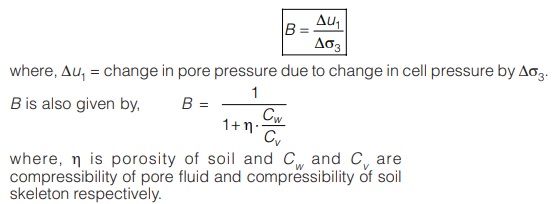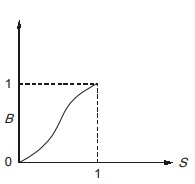Unconfined Compression Test
- It is a special case of triaxial test in which confining pressure is zero. It means only deviator or shear stress is applied.
- Since the specimen is laterally unconfined, the test is known as unconfined compression test.

- The axial or vertical compressive stress is the major principal stress and the other two principal stresses are zero.
- Since there is no cell pressure, no rubber membrane is required. Therefore, without rubber membrane (i.e. lateral support), sand and dry soils cannot be held in position. Hence, this test is applicable for saturated clays and silts. This test cannot be conducted on coarse grained soils such as sands and gravels.
- If axial force at failure is P, then

PORE PRESSURE PARAMETERS
- Sometimes, it is not possible to determine pore pressure practically, then theoretical approach given by Skempton can be adopted.
- Pore pressure parameters A and B are empirical coefficients which are used to express the response of pore pressure to changes in vertical pressure and lateral pressure under “undrain conditions”.
- They are dimensionless and indicate that a part of the total stress manifests as excess pore water pressure for the ‘no drainage’ condition.
- These parameters are very useful in field problems where pore pressure that are induced consequent to change in total stress may have to be computed, for e.g. in case of construction of earth embankment over a soft clay deposit.
Parameter B
- This parameter is defined under cell pressure stage and represents the ratio of change in pore
pressure to the change in cell pressure.
- B varies from 0 to 1 depending on the degree of saturation.
- B is zero for dry soil and is equal to unity for fully saturated soil.
- The relationship between degree of saturation, S and parameter, B is not linear.

Parameter A
- This parameter is valid in deviator stage and is defined in terms of another parameter A , such that A = A ⋅ B
- The parameter A represents the ratio of change in pore pressure to change in deviator stress during shear stage.

where ∆u2 = Change in pore pressure due to change in deviator stress.
- The parameter A depends upon strain in soil, degree of saturation, anisotropy, over consolidation ratio, stratification of soil etc. Its value may be as low as –0.5 for over consolidated soil with high O.C.R to as high as 3 for loose saturated sand.
- During loading, cell pressure and deviator stress both changes. Therefore total change in pore pressure will be

LIQUEFACTION OF SOIL
In loose saturated sand, on shear disturbance, there is decrease in volume as soil molecules comes closer. Hence pore pressure is set, due to which effective stress reduces suddenly. Hence this condition where a soil will undergo continued deformation at constant low residual effective stress or with zero effective stress is known as ‘Liquefaction of soil’. Liquefaction mostly occurs due to earthquake forces which induce high pore water pressure. When soil fails due to liquefaction, the structures founded on such soil sink. Increase in pore water pressure results in reduction in shear strength. Complete transfer of intergranular stress from soil grain to water is known as complete liquefaction. In this case, the effective stress is reduces to almost zero, and the sand water behaves as a viscous material.

